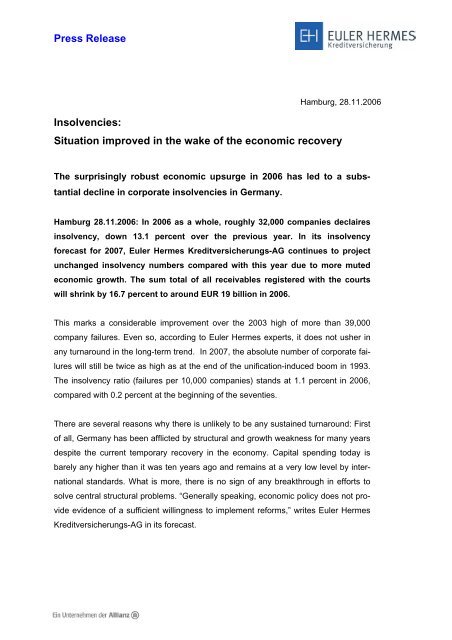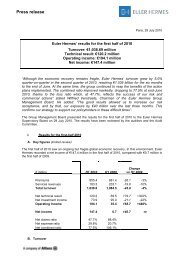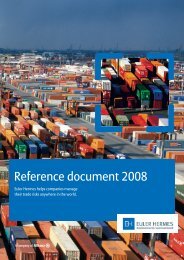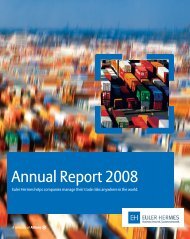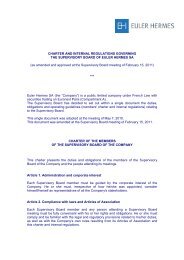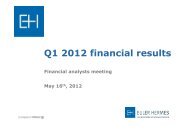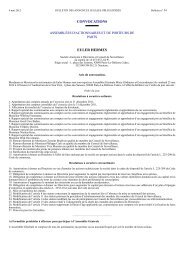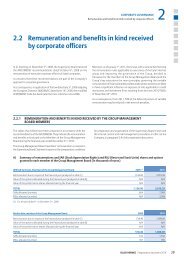Press Release Insolvencies - Euler Hermes Kreditversicherungs-AG
Press Release Insolvencies - Euler Hermes Kreditversicherungs-AG
Press Release Insolvencies - Euler Hermes Kreditversicherungs-AG
Create successful ePaper yourself
Turn your PDF publications into a flip-book with our unique Google optimized e-Paper software.
<strong>Press</strong> <strong>Release</strong><br />
<strong>Insolvencies</strong>:<br />
Hamburg, 28.11.2006<br />
Situation improved in the wake of the economic recovery<br />
The surprisingly robust economic upsurge in 2006 has led to a substantial<br />
decline in corporate insolvencies in Germany.<br />
Hamburg 28.11.2006: In 2006 as a whole, roughly 32,000 companies declaires<br />
insolvency, down 13.1 percent over the previous year. In its insolvency<br />
forecast for 2007, <strong>Euler</strong> <strong>Hermes</strong> <strong>Kreditversicherungs</strong>-<strong>AG</strong> continues to project<br />
unchanged insolvency numbers compared with this year due to more muted<br />
economic growth. The sum total of all receivables registered with the courts<br />
will shrink by 16.7 percent to around EUR 19 billion in 2006.<br />
This marks a considerable improvement over the 2003 high of more than 39,000<br />
company failures. Even so, according to <strong>Euler</strong> <strong>Hermes</strong> experts, it does not usher in<br />
any turnaround in the long-term trend. In 2007, the absolute number of corporate failures<br />
will still be twice as high as at the end of the unification-induced boom in 1993.<br />
The insolvency ratio (failures per 10,000 companies) stands at 1.1 percent in 2006,<br />
compared with 0.2 percent at the beginning of the seventies.<br />
There are several reasons why there is unlikely to be any sustained turnaround: First<br />
of all, Germany has been afflicted by structural and growth weakness for many years<br />
despite the current temporary recovery in the economy. Capital spending today is<br />
barely any higher than it was ten years ago and remains at a very low level by international<br />
standards. What is more, there is no sign of any breakthrough in efforts to<br />
solve central structural problems. “Generally speaking, economic policy does not provide<br />
evidence of a sufficient willingness to implement reforms,” writes <strong>Euler</strong> <strong>Hermes</strong><br />
<strong>Kreditversicherungs</strong>-<strong>AG</strong> in its forecast.
<strong>Press</strong> <strong>Release</strong><br />
At the same time, smaller businesses in particular with their insufficient liquidity and<br />
limited equity resources do not have any scope for warding off the risks arising from<br />
mounting globalization. In 2006, companies are continuing to make greater use of<br />
trade credit than short-term bank loans as a source of liquidity. Although this heightens<br />
the risk of a domino-like series of insolvencies, the results of a representative<br />
survey of companies conducted by <strong>Euler</strong> <strong>Hermes</strong> <strong>Kreditversicherungs</strong>-<strong>AG</strong> indicate<br />
that the majority of companies in Germany do not have sufficient debt collection<br />
management facilities.<br />
Sectors: Recovery in the construction industry continuing<br />
The relatively broad-based recovery in the economy is spurring all sectors. Even so,<br />
with a 20.8 percent decline in insolvencies in 2006, the construction industry is<br />
experiencing an above-average improvement for the fourth consecutive year. <strong>Insolvencies</strong><br />
are down 14.5 percent in the manufacturing sector, 12.3 percent down in<br />
trading and 9.9 percent down in the services industry.<br />
With roughly 15,600 failures, the service sector accounted for the largest share of<br />
corporate insolvencies in 2006, followed by trading companies (6,600), construction<br />
(6,200) and manufacturing companies (3,000). At 60 percent, the lion’s share of<br />
receivables registered with the courts was also attributable to services, followed by<br />
trading, manufacturing and construction.<br />
In the case of small businesses, sole proprietorships and professionals, which<br />
sustained a 2.9 percent increase in insolvencies in 2005, <strong>Euler</strong> <strong>Hermes</strong> expects an<br />
8.2 percent drop to 15,400 in 2006. At 48 percent, small businesses continue to<br />
account for a large share of corporate insolvencies. This is one of the consequences<br />
of the “Ich-<strong>AG</strong>” system established in 2003. These entities are frequently underfinanced<br />
and their proprietors do not have the necessary skills. <strong>Euler</strong> <strong>Hermes</strong> estimates<br />
that there are 305,000 such entities in existence.
<strong>Press</strong> <strong>Release</strong><br />
Regions: Bavaria bucking trend<br />
The decline in insolvencies in 2006 is evenly distributed between Western and Eastern<br />
Germany, with 24,500 cases registered in the West and 7,500 in the East. In<br />
North Rhine-Westphalia, which accounts for one quarter of insolvencies, the number<br />
dropped by 24.2 percent. Double-digit declines have also been recorded in<br />
Mecklenburg-West Pomerania (-20.9 percent), Berlin (-18.7 percent), Thuringia (-17.4<br />
percent) and Baden-Württemberg (-11.9 percent). Only Bavaria may report a slight<br />
increase in insolvency numbers according to the <strong>Euler</strong> <strong>Hermes</strong> forecasts.<br />
With respect to the relative frequency of insolvency, there remains a pronounced<br />
difference between the North and the South on the one hand and the East and the<br />
West on the other, a situation which has barely been altered by the 2006 figures. For<br />
example, Saxony-Anhalt in the East has the highest insolvency ratio of 184 per<br />
10,000 companies, while Rhineland-Palatinate has a ratio of only 103. At 62, Baden-<br />
Württemberg has one of the lowest figures but Schleswig-Holstein has a figure of 131.<br />
International situation: Europe and the United States with disparate trends<br />
Internationally, there is also evidence of a substantial improvement in the insolvency<br />
situation. According to the global <strong>Euler</strong> <strong>Hermes</strong> Insolvency Index, the risk of insolvency<br />
in the industrialized nations dropped by ten percent in 2006, following on from<br />
the four percent rise in the previous year. Yet this positive trend conceals considerable<br />
discrepancy between figures in the United States on the one hand and European<br />
figures on the other.<br />
The extraordinary increase of 14 percent in 2005 in the United States is less the<br />
result of economic factors than the reflection of the effects of a new insolvency law,<br />
which came into effect in mid October 2005. This heightened the incentive on the part<br />
of many companies to file for insolvency under the old law. The massive growth was<br />
followed by a 20 percent decline in 2006.
<strong>Press</strong> <strong>Release</strong><br />
In Western Europe, the total number of corporate insolvencies stands at 160,300 in<br />
2006, a drop of just under five percent. If it had not been for Germany, which exerts a<br />
material influence on trends, the decline would have been only half as great. Figures<br />
vary considerably from country to country. Thus there was an increase in the United<br />
Kingdom (+8.3 percent), Ireland (+7.0 percent), Greece (+5.1 percent) and Spain<br />
(+4.7 percent), while sharp declines were recorded in Norway (-20.9 percent),<br />
Denmark (-15.8 percent), Sweden (-14.9 percent) and Germany (-13.1 percent)<br />
Looking ahead to 2007, <strong>Euler</strong> <strong>Hermes</strong> assumes that the differences amongst the individual<br />
European countries are likely to fade. Altogether, the positive trend of 2006 will<br />
not continue in Western Europe, with the index set to rise by 0.5 percent. In fact, the<br />
experts project an increase of ten percent in the United States.<br />
Charts and figures on this topic can be found on the Internet at www.eulerhermes.de under the heading <strong>Press</strong>.<br />
<strong>Euler</strong> <strong>Hermes</strong> is the world-wide leader in credit insurance and one of the leaders in bonding and guarantees.<br />
With 5,400 employees in 46 countries, <strong>Euler</strong> <strong>Hermes</strong> offers a complete range of services for the management of<br />
customer receivables. The group posted a 2 billion Euro turnover in 2005.<br />
<strong>Euler</strong> <strong>Hermes</strong>, subsidiary of <strong>AG</strong>F and a member of Allianz, is listed on Euronext Paris. The group and its<br />
principal credit insurance subsidiaries are rated AA- by Standard & Poor’s.<br />
Contact:<br />
<strong>Euler</strong> <strong>Hermes</strong> <strong>Kreditversicherungs</strong>-<strong>AG</strong> :<br />
Uwe Kniehs<br />
Friedensallee 254<br />
22763 Hamburg<br />
Phone + 49 (0) 40 88 34 1033<br />
Fax: + 49 (0) 40 88 34 1015<br />
Uwe.Kniehs@eulerhermes.com<br />
www.eulerhermes.de<br />
These assessments are, as always, subject to the disclaimer provided below.<br />
Cautionary Note Regarding Forward-Looking Statements: Certain of the statements contained herein may be statements of future expectations and other forward-looking statements that are based on<br />
management's current views and assumptions and involve known and unknown risks and uncertainties that could cause actual results, performance or events to differ materially from those expressed or implied in<br />
such statements. In addition to statements which are forward-looking by reason of context, the words ‘may, will, should, expects, plans, intends, anticipates, believes, estimates, predicts, potential, or continue’ and<br />
similar expressions identify forward-looking statements. Actual results, performance or events may differ materially from those in such statements due to, without limitation, (i) general economic conditions, including<br />
in particular economic conditions in the Allianz Group's core business and core markets, (ii) performance of financial markets, including emerging markets, (iii) the frequency and severity of insured loss events, (iv)<br />
mortality and morbidity levels and trends, (v) persistency levels, (vi) the extent of credit defaults (vii) interest rate levels, (viii) currency exchange rates including the Euro-U.S. Dollar exchange rate, (ix) changing<br />
levels of competition, (x) changes in laws and regulations, including monetary convergence and the European Monetary Union, (xi) changes in the policies of central banks and/or foreign governments, (xii) the<br />
impact of acquisitions, including related integration issues, (xiii) reorganization measures and (xiv) general competitive factors, in each case on a local, regional, national and/or global basis. Many of these factors<br />
may be more likely to occur, or more pronounced, as a result of terrorist activities and their consequences.<br />
The matters discussed herein may also involve risks and uncertainties described from time to time in Allianz <strong>AG</strong>’s filings with the U.S. Securities and Exchange Commission. The Group assumes no obligation to<br />
update any forward-looking information contained herein.


